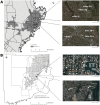Diel activity patterns of two distinct populations of Aedes aegypti in Miami, FL and Brownsville, TX
- PMID: 35351905
- PMCID: PMC8964714
- DOI: 10.1038/s41598-022-06586-w
Diel activity patterns of two distinct populations of Aedes aegypti in Miami, FL and Brownsville, TX
Abstract
The diel biting activity of Aedes (Stegomyia) aegypti (L) populations was extensively investigated in the early 1900s to gain more information on the biology of Ae. aegypti, and this information was used to devise effective approaches to controlling populations of this species and protect the human population from widespread arbovirus outbreaks. However, few contemporary studies are available regarding the diel activity patterns of Ae. aegypti. To assess the diel activity patterns of Ae. aegypti in southern Florida and Texas, we conducted 96-h uninterrupted mosquito collections once each month from May through November 2019 in Miami, Florida, and Brownsville, Texas, using BG-Sentinel 2 Traps. The overall diel activity pattern in both cities was bimodal with morning and evening peak activity between 7:00 and 8:00 and between 19:00 and 20:00. There were significant daily, monthly, seasonal, and site-specific differences in activity patterns, but these differences did not affect the overall peak activity times. These differences suggest daily, monthly, seasonal, and site-specific variations in human exposure to Ae. aegypti. Our observations can be used in planning and executing Ae. aegypti vector control activities in southern Florida and southern Texas, specifically those targeting the adult mosquito populations.
© 2022. The Author(s).
Conflict of interest statement
The authors declare no competing interests.
Figures





References
-
- Christophers SR. Aedes aegypti (L) the Yellow Fever Mosquito: Life History. Cambridge University Press; 1960.
-
- Lumsden WHR. The activity cycle of domestic Aedes (Stegomyia) aegypti (L.) (Diptera, Culicidae) in Southern Province, Tanganyika. Bull. Ent. Res. 1957;48:769–782. doi: 10.1017/S0007485300002881. - DOI
-
- Chadee DD, Martinez R. Landing periodicity of Aedes aegypti with implications for dengue transmission in Trinidad, West Indies. J. Vector Ecol. 2000;25:158–163. - PubMed
-
- Diarrassouba S, Dossou-Yovo J. Atypical activity rhythm in Aedes aegypti in a sub-Sudanian savannah zone of Côte d'Ivoire. Bull. Soc. Pathol. Exot. 1997;90:361–363. - PubMed
Publication types
MeSH terms
Grants and funding
LinkOut - more resources
Full Text Sources

